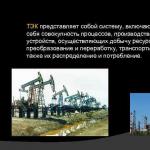Presentation on the topic of the fuel industry. A presentation on the topic of the Russian fuel industry was prepared by a student. Fuel industry presentation
Fuel industry
Fuel industries: oil gas coal peat shale uranium
Oil industry Drilling rig on the river. Ukhta. 1868
Methods of oil production: fountain (cheaper) pumping
Reserves: 2nd place in the world after Saudi Arabia (20 billion tons - 13% of the world's total) Production: Maximum in 1987 - 560 million tons - 1st place in the world, 2004 - 459 million tons - 2 place in the world, 2007 – 491 million tons.
Oil production bases: West Siberian (70% of production in the country) - Samotlor (the largest in Russia in terms of production), Surgutskoye, Megionskoye, Mamontovskoye, Fedorovskoye, Ust-Balykskoye Volga-Ural (25% of production) - Romashkinskoye, Tuymazinskoye, Ishimbaevskoye, Mukhanovskoye Barents-Pechorskaya – Usinskoye
Gas industry Reserves: 1st place in the world (160 trillion m³ - 45% of the global total) Production: 1st place in the world 1991 - 643 billion m³ 1997 - 643 billion m³ 1999 - 591 billion m³ 2005 g – 598 billion m³ 2006 – 656 billion m³ Gas production bases: West Siberian (92% of production in the country) – Urengoyskoye (the largest in Russia in terms of production), Yamburgskoye, Gubkinskoye, Medvezhye, Bovanenkovskoye Orenburg-Astrakhan (6% of production ) – Orenburgskoye, Astrakhanskoye Timan-Pechorskaya (1% of production) – Ukhta, Shtokmanovskoye
Russia accounts for 37% of global natural gas exports Italy is supplied 28% with Russian gas Germany 33% Bulgaria 38% Hungary 50% Poland 60% Austria 75% Switzerland 100%
Coal industry Reserves: 1st place in the world (6.4 trillion tons - 23% of the world's total) Production: 1990 - 395 million tons 1997 - 244 million tons 2000 - 210 million tons 2007 – 314 million tons – 3rd place in the world after China, USA 60% of coal is mined by open pit mining
Coal basins: Kuznetsk (Kuzbass) - 1/3 of Russian production, Kansko-Achinsk - 13% of production, Donetsk (Donbass) - 9% of production, Pechora - 8% of production, Moscow Region, Irkutsk, South Yakutsk
Characteristics of the main coal basins Basin Share of underground mining, % Average depth of mining, m Average thickness of seams, m Calorific value of coal, thousand kcal/kg Production, million tons Kuzbass 58 185 1.85 0.88 98 Pechora 100 298 1, 53 0.8 22.7 Kansko-Achinsky - - 15-100 0.47 32.0
Practical work No. 1 “Characteristics of one of the oil production areas based on maps and statistical materials” Plan for comparative characteristics of oil bases Geographical location relative to consumers How the basins are explored Degree of basin development Method of production Oil quality Transportation conditions Ecological and economic problems and prospects for the development of oil fields Assignment: Using textbook text and a thematic map showing the location of the country's main energy bases, compare and give a brief description of two oil or gas basins:
Homework § 2 Mark nomenclature objects on the contour map
The Russian fuel industry is a combination of several industries that are engaged in the extraction and processing of fuel. These are the gas, coal, shale and peat industries, as well as the oil production and oil refining industries. Enterprises of all these industries are part of the fuel and energy complex (abbreviated as FEC).
 The fuel and energy complex is a system that includes a set of processes, industries, devices that extract resources, transform and process them, transport, as well as their distribution and consumption.
The fuel and energy complex is a system that includes a set of processes, industries, devices that extract resources, transform and process them, transport, as well as their distribution and consumption.

 Mineral fuel is the main source of energy in modern economies and the most important industrial raw material. In terms of fuel resources, Russia ranks 1st in the world. Their regional structure is characterized for the most part by the clear predominance of coal, but it does not always play a leading role as a condition for the development of the fuel base of industry. In Western Siberia, the Volga region, the North Caucasus and the Urals, oil and natural gas are of paramount importance from this point of view.
Mineral fuel is the main source of energy in modern economies and the most important industrial raw material. In terms of fuel resources, Russia ranks 1st in the world. Their regional structure is characterized for the most part by the clear predominance of coal, but it does not always play a leading role as a condition for the development of the fuel base of industry. In Western Siberia, the Volga region, the North Caucasus and the Urals, oil and natural gas are of paramount importance from this point of view.
 Along with the rapid development of the fuel industry, fuel production became dispersed throughout the country. The areas of fuel production and consumption seem to have become closer to each other. The resources of the European part are most intensively developed, but fuel consumption here far exceeds its production. In the Eastern regions it is the other way around. As a result, an ever-increasing flow of fuel is sent from here to the European part, and a certain amount of oil and gas is exported. The uneven distribution of fuel resources across the country is proven by the following map.
Along with the rapid development of the fuel industry, fuel production became dispersed throughout the country. The areas of fuel production and consumption seem to have become closer to each other. The resources of the European part are most intensively developed, but fuel consumption here far exceeds its production. In the Eastern regions it is the other way around. As a result, an ever-increasing flow of fuel is sent from here to the European part, and a certain amount of oil and gas is exported. The uneven distribution of fuel resources across the country is proven by the following map.

 To date, the exploration of the areas of the European part of the country and Western Siberia reaches 65-70% for oil and 40-45% for gas, while Eastern Siberia and the Far East are only 68% explored, and the sea shelves are only 1%. However, it is these inaccessible regions that account for about 46% of promising and over 50% of forecast oil resources and up to 80% of natural gas.
To date, the exploration of the areas of the European part of the country and Western Siberia reaches 65-70% for oil and 40-45% for gas, while Eastern Siberia and the Far East are only 68% explored, and the sea shelves are only 1%. However, it is these inaccessible regions that account for about 46% of promising and over 50% of forecast oil resources and up to 80% of natural gas.
 The oil industry is engaged in the production and transportation of oil and the production of associated gas. Russia is exceptionally rich in oil. Oil is almost never used in its raw form, but during processing it produces high-quality fuel (gasoline, kerosene, diesel fuel, fuel oil) and various compounds that serve as raw materials for the chemical industry. In terms of oil reserves, Russia ranks 2nd in the world. Method of production: drilling wells.
The oil industry is engaged in the production and transportation of oil and the production of associated gas. Russia is exceptionally rich in oil. Oil is almost never used in its raw form, but during processing it produces high-quality fuel (gasoline, kerosene, diesel fuel, fuel oil) and various compounds that serve as raw materials for the chemical industry. In terms of oil reserves, Russia ranks 2nd in the world. Method of production: drilling wells.
 Reliable oil reserves in Russia in 2011 are 10.6 billion tons. Production is carried out by the Rosneft holding, the companies Lukoil, Surgutneftegaz, YUKOS. The main oil fields are: Western Siberia-Khanty-Mansiysk a. O. -70% from the Russian Federation, including more than 2/3 of production: Samotlorskoye, Ust-Balykskoye, Megionskoye, Yuganskoye, Kholmogorskoye, Varieganskoye, Yamal Peninsula. Volga-Ural province 24%. : Romashkinskoe, Tuymazinskoe, Shkapovskoe, Mukhanovskoe, Yarinskoe. Timan-Pechora province - 3%: Usinsk, Vozeiskoe. North Caucasus, o. Sakhalin, Caspian Sea.
Reliable oil reserves in Russia in 2011 are 10.6 billion tons. Production is carried out by the Rosneft holding, the companies Lukoil, Surgutneftegaz, YUKOS. The main oil fields are: Western Siberia-Khanty-Mansiysk a. O. -70% from the Russian Federation, including more than 2/3 of production: Samotlorskoye, Ust-Balykskoye, Megionskoye, Yuganskoye, Kholmogorskoye, Varieganskoye, Yamal Peninsula. Volga-Ural province 24%. : Romashkinskoe, Tuymazinskoe, Shkapovskoe, Mukhanovskoe, Yarinskoe. Timan-Pechora province - 3%: Usinsk, Vozeiskoe. North Caucasus, o. Sakhalin, Caspian Sea.

 Oil refining 28 enterprises (300 million tons per year); 6 oil refineries. Refineries: Omsk, Yaroslavl, Ryazan (18 million tons each), Ufa, Volgograd, Saratov, Perm, Moscow, Kirishi, Tuapse, Angarsk, Khabarovsk.
Oil refining 28 enterprises (300 million tons per year); 6 oil refineries. Refineries: Omsk, Yaroslavl, Ryazan (18 million tons each), Ufa, Volgograd, Saratov, Perm, Moscow, Kirishi, Tuapse, Angarsk, Khabarovsk.

 Oil transportation Sections of the Druzhba oil pipeline The length of Russian oil pipelines is 48 thousand km. The center of the oil pipeline system is Almetyevsk (the beginning of the Druzhba oil pipeline). Lines diverge from it to the east (to Angarsk), northwest (to St. Petersburg and Kirishi), west (to Brest), southwest (to Novorossiysk, a large oil loading port in Russia). The service life of the oil pipeline is 33 years. about 70% of oil pipelines are badly worn out, which leads to accidents on them. And this is unsafe for the environment and people
Oil transportation Sections of the Druzhba oil pipeline The length of Russian oil pipelines is 48 thousand km. The center of the oil pipeline system is Almetyevsk (the beginning of the Druzhba oil pipeline). Lines diverge from it to the east (to Angarsk), northwest (to St. Petersburg and Kirishi), west (to Brest), southwest (to Novorossiysk, a large oil loading port in Russia). The service life of the oil pipeline is 33 years. about 70% of oil pipelines are badly worn out, which leads to accidents on them. And this is unsafe for the environment and people
 The gas industry is the youngest and fastest growing branch of the fuel industry in Russia. It provides consumers with cheap and convenient fuel. Russia has 48 trillion m3, or over 2/5 of the world's proven natural gas reserves. Production is carried out by: RAO Gazprom, Tyumenburgaz, Urengoygazprom, Yamburggazdobycha. offshore gas production Method of extraction: well drilling
The gas industry is the youngest and fastest growing branch of the fuel industry in Russia. It provides consumers with cheap and convenient fuel. Russia has 48 trillion m3, or over 2/5 of the world's proven natural gas reserves. Production is carried out by: RAO Gazprom, Tyumenburgaz, Urengoygazprom, Yamburggazdobycha. offshore gas production Method of extraction: well drilling
 Main gas fields: Western Siberia: - 90% of Russian gas production: Urengoyskoye, Yamburgskoye, Medvezhye, Zapolyarnoye. European North - Vuktylskoe. Ural-Volga region-Orenburg, Astrakhan (g/k) (6%) North Caucasus, o. Sakhalin, Yamal Peninsula, Barents Sea shelf. types of wells for gas production
Main gas fields: Western Siberia: - 90% of Russian gas production: Urengoyskoye, Yamburgskoye, Medvezhye, Zapolyarnoye. European North - Vuktylskoe. Ural-Volga region-Orenburg, Astrakhan (g/k) (6%) North Caucasus, o. Sakhalin, Yamal Peninsula, Barents Sea shelf. types of wells for gas production
 Gas processing Gas processing plants: Tuymazy, Shkapovo, Almetyevsk, Otradnoye, Krasnodar, Grozny, Nizhnevartovsk, Pravdinsk Gas condensate plants: Astrakhan, Orenburg. Gas processing plants
Gas processing Gas processing plants: Tuymazy, Shkapovo, Almetyevsk, Otradnoye, Krasnodar, Grozny, Nizhnevartovsk, Pravdinsk Gas condensate plants: Astrakhan, Orenburg. Gas processing plants

 Gas transportation Gas pipelines in the Russian Federation amount to 150 thousand km. The main ones: “Brotherhood”, “Union”, “Progress” to Europe, CIS, (“Blue Stream” through Turkey to Southern Europe, to China in the future, Nord Stream. North European Gas Pipeline
Gas transportation Gas pipelines in the Russian Federation amount to 150 thousand km. The main ones: “Brotherhood”, “Union”, “Progress” to Europe, CIS, (“Blue Stream” through Turkey to Southern Europe, to China in the future, Nord Stream. North European Gas Pipeline

 The coal industry significantly exceeds all other branches of the fuel industry in terms of the number of workers and the cost of production fixed assets. Russia has significant proven coal reserves - 193.3 billion tons, including brown - 101.2 billion tons, hard coal - 85.3 billion tons (including coking - 39.8 billion tons), anthracite - 6.8 billion tons
The coal industry significantly exceeds all other branches of the fuel industry in terms of the number of workers and the cost of production fixed assets. Russia has significant proven coal reserves - 193.3 billion tons, including brown - 101.2 billion tons, hard coal - 85.3 billion tons (including coking - 39.8 billion tons), anthracite - 6.8 billion tons
 Extraction method: mines, quarries (open-pit mines: KATEK, South Yakutsky). 66% of open pit mining. 2500 (brown)-8600 (stone) kcal.
Extraction method: mines, quarries (open-pit mines: KATEK, South Yakutsky). 66% of open pit mining. 2500 (brown)-8600 (stone) kcal.
 Coal deposits: Tungussky, Lensky, Pechora - 3.5%, Donetsk (Rostov region), South Yakutsky, Irkutsk-Cheremkhovsky. Brown coal: Podmoskovny. Kansko-Achinsky and other Kuznetsk Tunguska basins contain 4/5 Lensky reserves Kansko-Achinsky coal of the Russian Federation Share of coal basins in coal production in Russia, 2011 Ural 2% Other 5% Donbass 2% Pechora 5% Eastern Siberia 12% Far East 11 % Kansko-Achinsky 11% Kuznetsky 52%
Coal deposits: Tungussky, Lensky, Pechora - 3.5%, Donetsk (Rostov region), South Yakutsky, Irkutsk-Cheremkhovsky. Brown coal: Podmoskovny. Kansko-Achinsky and other Kuznetsk Tunguska basins contain 4/5 Lensky reserves Kansko-Achinsky coal of the Russian Federation Share of coal basins in coal production in Russia, 2011 Ural 2% Other 5% Donbass 2% Pechora 5% Eastern Siberia 12% Far East 11 % Kansko-Achinsky 11% Kuznetsky 52%
 The oil shale industry is engaged in the extraction and primary processing of oil shale. 0.2 million tons were produced. In terms of reserves, Russia ranks one of the first places in the world. Shales are used as local fuel, as well as for the production of gas, fuel oil, oils, and shale resin. The deposits began to be developed at the beginning of the 20th century.
The oil shale industry is engaged in the extraction and primary processing of oil shale. 0.2 million tons were produced. In terms of reserves, Russia ranks one of the first places in the world. Shales are used as local fuel, as well as for the production of gas, fuel oil, oils, and shale resin. The deposits began to be developed at the beginning of the 20th century.  Peat mining began in Russia in the 18th century in the vicinity of St. Petersburg. For the 1990s Peat production has decreased because it is an economically inefficient type of fuel. Peat is used as local fuel and also as fertilizer
Peat mining began in Russia in the 18th century in the vicinity of St. Petersburg. For the 1990s Peat production has decreased because it is an economically inefficient type of fuel. Peat is used as local fuel and also as fertilizer
 The main peat extraction areas in Russia are Western Siberia, the Kirov region and the north of the European part of the Russian Federation. Peat pots The volume of peat production in recent years has decreased by approximately 2.0 times, which is due almost exclusively to one factor - a multiple drop in its production in Russia. As for other countries, peat production generally increased by 10%.
The main peat extraction areas in Russia are Western Siberia, the Kirov region and the north of the European part of the Russian Federation. Peat pots The volume of peat production in recent years has decreased by approximately 2.0 times, which is due almost exclusively to one factor - a multiple drop in its production in Russia. As for other countries, peat production generally increased by 10%.
 The wood industry is engaged in the extraction and processing of wood as fuel. Extraction method: sawmilling. Wood (calorie content 2000 -2500 kcal). Centers for distribution of raw materials: European North (obvious overcutting of forests, forest area is decreasing) Eastern Siberia Far East.
The wood industry is engaged in the extraction and processing of wood as fuel. Extraction method: sawmilling. Wood (calorie content 2000 -2500 kcal). Centers for distribution of raw materials: European North (obvious overcutting of forests, forest area is decreasing) Eastern Siberia Far East.
 The Russian fuel industry is one of the most important branches of heavy industry. And over the years, the role of the Russian fuel industry is only increasing, because various types of fuel are used to provide energy to industrial enterprises and act as raw materials in many industries. In fact, it is connected with the entire industry of Russia. It also plays an important role in providing the population with heat, electricity, and hot water. In Russia, the implementation of state policy in the field of the fuel industry is entrusted to the Ministry of Energy and its subordinate structures and organizations, including the Russian Energy Agency.
The Russian fuel industry is one of the most important branches of heavy industry. And over the years, the role of the Russian fuel industry is only increasing, because various types of fuel are used to provide energy to industrial enterprises and act as raw materials in many industries. In fact, it is connected with the entire industry of Russia. It also plays an important role in providing the population with heat, electricity, and hot water. In Russia, the implementation of state policy in the field of the fuel industry is entrusted to the Ministry of Energy and its subordinate structures and organizations, including the Russian Energy Agency.

Slide 1
“TEK. Fuel resources.”

Slide 2
Structure of the fuel and energy complex

Slide 3
Russia's share in the world

Slide 4
Dynamics of fuel production in Russia for 1990-2006

Slide 5
Geological section of the oil and gas province

Slide 6
Oil production in Russian regions, 2001

Slide 7
Oil characteristics
Oil is a flammable oily liquid. One of the most important characteristics is the density of oil: light, medium and heavy oil are distinguished. For specialists, indicators such as the initial boiling point (+28 degrees) and flash point (35-120 degrees) are also important.
Oil is classified by sulfur content into: low-sulfur (up to 0.5% S), sulfur (0.5 - 2% S) and high-sulfur (over 2%). By distillation, gasoline, jet fuel, kerosene, diesel fuel, and fuel oil are obtained from oil.

Slide 8
Oil refineries
The oil refining industry is a manufacturing industry that produces petroleum products from crude oil. Petroleum products are mixtures of hydrocarbons, as well as individual chemical compounds obtained from oil and petroleum gases. Used as fuels, lubricants and electrical insulating materials, solvents, road coatings, petrochemical raw materials, etc. Among the largest oil refineries in Russia is the Nizhnekamsk Oil Refinery.

Slide 9
Oil transportation
The length of Russian oil pipelines is 48 thousand km. The center of the oil pipeline system is Almetyevsk (the beginning of the Druzhba oil pipeline). Lines diverge from it to the east (to Angarsk), northwest (to St. Petersburg and Kirishi), west (to Brest), southwest (to Novorossiysk, a large oil loading port in Russia). The service life of the oil pipeline is 33 years. about 70% of oil pipelines are badly worn out, which leads to accidents on them. And this is unsafe for the environment and people.

Slide 10
Gas industry
Russia ranks first in the world in terms of gas reserves and production. More than 700 deposits have been explored. Main gas production bases: Western Siberia (north) - 92% of all production (only 6% of reserves have been extracted!) Orenburg-Astrakhan - 6% of all-Russian production, gas contains many impurities and needs purification. Large gas processing complexes have been built in production areas. Timan-Pechora basin – 1% of production.

Slide 11
Gas transportation
A unified gas pipeline system has been created in Russia, through which gas is transferred from Urengoy and Orenburg (the main centers) to consumers. Gas pipelines: “Shine of the North” - through the north of Russia to the CIS countries in the west; "Blue Stream" - through the Black Sea to Turkey. Projects for gas transportation from the Irkutsk region are being developed. to Mongolia, Japan, China, South Korea. During the extraction process, a lot of gas is burned (see photo), which gives additional carbon dioxide emissions into the atmosphere. Gas flares over Western Siberia are visible even from space.

Slide 12
Industry problems.
The bulk of fuel resources are concentrated in the east of Russia, while consumers are in the west. The main oil and gas basins are Western Siberia and the Ural-Volga region. The industry is characterized by high costs of fuel production. More than 50% of produced oil and about 70% of gas are exported. Meanwhile, it is more profitable to export not raw materials, but finished products - for example, petroleum products. Existing oil refineries in Russia require reconstruction, since their equipment is old, so the depth of oil refining is only 72%, and the quality of oil products does not meet international standards. Fuel industry enterprises are strong polluters of the environment, so it is necessary to review environmental policies in mining areas.

Slide 13
World reserves of some types of minerals.

Slide 19
The presentation was made by
Chugainov Maxim. Kanyukov Sergey.

Fuel industry
fuel production
resources
recycling
fuel
resources

Composition of fuel and energy complex
Transporti
roving
Fuel
industry
Electro
energy
Transfer of fuel and energy (via power lines)
Energy production
Fuel extraction
- oil
- gas
- coal
- peat
- shale
- TPP(thermal)
- hydroelectric power station(on rivers)
- NPP(on uranium)
- WPP(wind)
- SES(solar)
- PES(tidal)
- GeoTES(geothermal)
pipeline
gas pipeline

Main industries
- Oil
- Gas
- Coal
10% of world reserves, 2nd place in production
40% of world reserves, 1st place in production
50% of world reserves,
5th place in the world

- EGP of the main basins, fields.
- Reserves, production.
- Conditions and methods of extraction.
- Use and processed products.
- Main methods of transportation.
- The main Russian enterprises and companies in the industry.
- Industry problems.
- Development prospects.



1. EGP of the main basins, fields
- West Siberian:
2/3 of oil production
Samotlor, Surgut
- Volgo-Ural
1/4 of oil production
Romashkinskoye,
Tuymazinskoe
- Offshore production
Caspian Sea
Barencevo sea
Sea of Okhotsk

2. Reserves, production

3. Conditions and methods of production
Pumping
fountain

4. Use and processed products
- For the manufacture of plastics
- Chemical fibers
- Polymers

- Petrol
- Kerosene
- Fuel
- Diesel fuel
- Fuel oil

5. Main methods of transportation
Oil pipelines
Length-
- Length - 48,000 km.
- Center of the oil pipeline system Almetyevsk
Textbook p. 101-102

6. Main Russian enterprises and companies in the industry
- Refineries located in areas consuming petroleum products
- 80% of refineries are in the European part of the country
- Located in major cities of the country (Moscow, Ufa, Ryazan, Yaroslavl, Perm, Saratov, Kirishi)

L angepas U paradise TO ogalymneft

- Oil is a non-renewable mineral
- Environmental pollution
- Export of crude oil (not economically profitable)
- Lack of modern equipment
- Replacement of an outdated oil pipeline

8. Development prospects
Textbook P. 100
Today in the Russian Federation there are 36 universities , training professionals for the oil and gas industry, as well as 73 universities related areas or having petroleum faculties. 10 Top positions among them should be given to:


Gas – cheap type of fuel, least pollutes the environment
- 1st place in the world
- 160 trillion m³
- 45% of world reserves

- Ukraine
- Belarus
- Western Europe
- Baltic countries
- Türkiye

Gas bases:
- Western Siberia:
90% of gas production
Urengoyskoye,
Yamburgskoe
- Orenburg - Astrakhan
6% of gas production
Orenburgskoe,
Astrakhan
- Timan-Pechorskaya
1% of gas production
Shtokmanovskoe

Unified gas pipeline system
- Length
- 150,000 km



- Fuel for industry
- TPP
- Raw materials for ferrous metallurgy
- Raw materials for the chemical industry

- 2nd place – brown coal
- 6th place – hard coal
- 23% of world reserves
- 6 trillion tons

The coal industry of the Russian Federation is a complex of industries for the extraction, enrichment and processing of coal
Type of coal
Extraction methods

- Main pool
- Reserves 725 billion tons
- Disadvantage

- Lignite basin
- Low quality coal
- Providing thermal power plants

- Difficult climatic conditions
- Expensive extraction

- Largest in reserves
- There is no mining!!!

- Expensive transportation
- Equipment modernization required

Characteristics plan a) geographical location; b) the place of the basin among other basins in the country according to main indicators; c) development problems.
Pool
Blacksmith
Share of underground mining, %
58
Average mining depth, m
Pechora-sky
Kansko-Achinsky
185
100
Average thickness of layers, m
1,85
…
Calorific value of coal, thousand kcal/kg
Podmoskovy
298
82
…
1,53
Production (2003), million tons
0,88
131
15-100
62
0,8
13
0,47
2,21
34
0,37
3,3

- § 2
- Practical work
- Map





